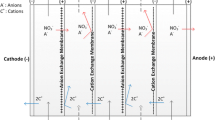Abstract
HIGH levels of nitrate in ground water can pose a serious health risk. Reduction of nitrate to nitrite in the gut may cause methemoglobinaemia1both in newborn infants and in adults deficient in glucose-phosphate dehydrogenase2. Under abnormal circumstances, reduction to nitrite can also occur in the stomach to form N-nitrosamines, a postulated cause of stomach cancer3. Nitrate outflow onto shallow continental shelves can promote nearshore algal blooms. Both natural and anthropogenic sources contribute to nitrate pollution. In the United States4 and Europe5, legislation now specifies a maximum permissible nitrate level in drinking water. Techniques such as selective ion exchange6, reverse osmosis, electrodialysis and distillation exist to transfer nitrate between two bodies of water, but only biological processes are presently available for nitrate destruction. Here I describe a chemical process in which aluminium powder reduces nitrate to ammonia, nitrogen and nitrite. In a pH range of 9 to 10.5, selective reduction of nitrate relative to sulphate is possible, and between pH 9.1 and 9.3, loss of the reductant through decomposition of water can be minimized to less than 2%. Subsequent control of pH and concentrations of dissolved aluminium, nitrite and ammonia should be possible at a realistic cost, making this process potentially useful for combating nitrate pollution.
Similar content being viewed by others
References
Walton, G. Am. J. Public Health 41, 986–995 (1951).
Challis, B. C. Nature 244, 466 (1973).
Mirvish, S. Nature 315, 461–462 (1985).
U.S. Congress 93, Session 433 Safe Drinking Water Act Public Law 93-523 (1974).
Eur. Chem. Industry Ecol. Toxicol. Centre Tech. Report No. 27 (Brussels, Belgium, 1988).
Hoek, J. P. van der et al. Wat. Air & Soil Pollut. 37, 41–53 (1988).
Weast, R. C. (ed.) Handbook of Chemistry and Physics 65 edn, D155–D158 (Chemical Rubber Company, Boca Raton, 1976).
Murphy, A. P. U.S. Patent applied for August 1990.
Pontius, F. W. (eds) Water Quality and Treatment 4th edn, 168 (McGraw-Hill, New York, 1990).
Mioduszewski, D. Wat. & Wastes Engng 12, 34–46 (1975).
Wolfe, R. L. et al. J. Am. Water Works Assoc. 76, 74 (1984).
Pressley, T. A. et al. Envir. Sci. Technol. 6, 622 (1972).
Diyamandoglu, V. et al. Envir. Sci. Technol. 24, 1711 (1990).
Author information
Authors and Affiliations
Rights and permissions
About this article
Cite this article
Murphy, A. Chemical removal of nitrate from water. Nature 350, 223–225 (1991). https://doi.org/10.1038/350223a0
Received:
Accepted:
Issue Date:
DOI: https://doi.org/10.1038/350223a0
- Springer Nature Limited
This article is cited by
-
The Effects of Shaking Duration on the Abundance and the Community of Aerobic Denitrifying Bacteria in Shrimp Pond Water and Sediment Samples
Current Microbiology (2023)
-
Experimental and economic evaluation of nitrate removal by a nanofiltration membrane
Environmental Science and Pollution Research (2023)
-
Metallic iron for environmental remediation: the still overlooked iron chemistry
Applied Water Science (2023)
-
Applications of phytoremediation to treat reclaimed water in urban parks using aquatic macrophytes
Aquatic Ecology (2022)
-
Denitrification on PdCu-AC with hydrogen from electrocatalytic water splitting
Research on Chemical Intermediates (2021)





